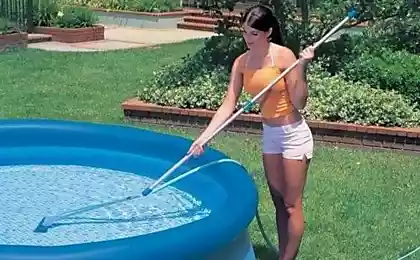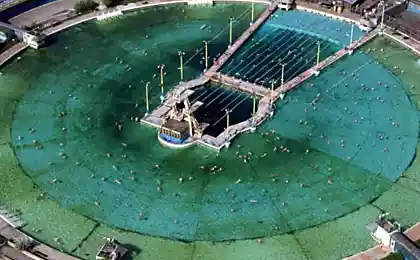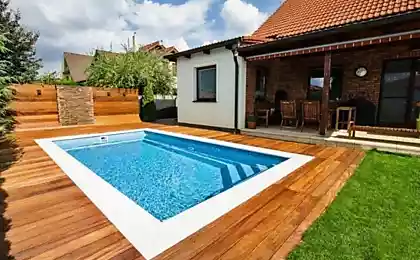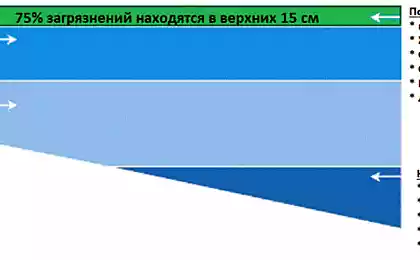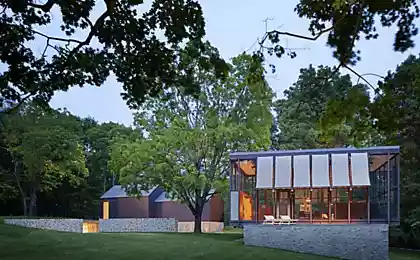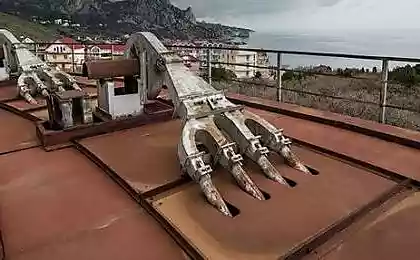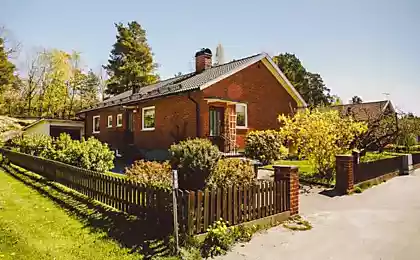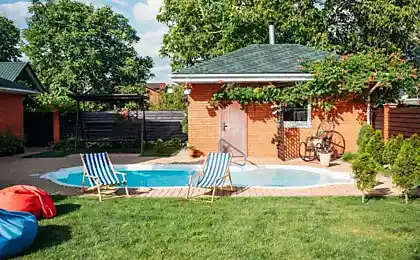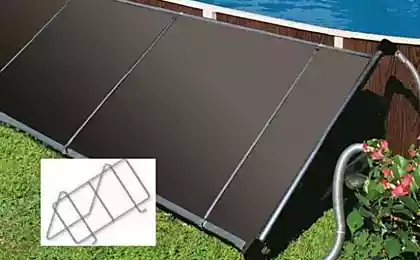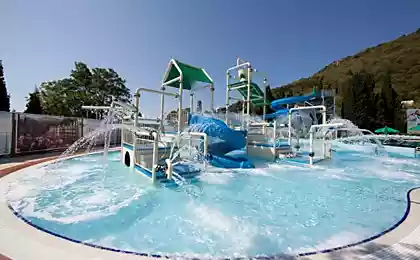781
The nuances of the arrangement of pools or baths in a private house
It is difficult to find the owner of a country house, who has ever wondered about the construction of the pool or the baptismal font in the house. This desire is understandable. Captivating opportunity to swim whatever the time of year and weather conditions, and with what incomparable pleasure from bathing.
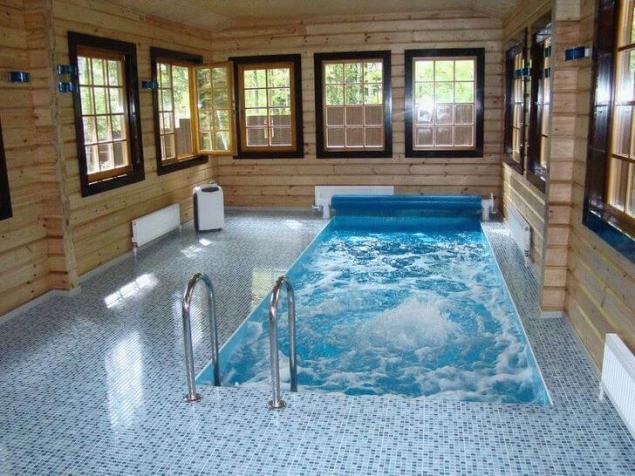
Many novice developers think that to make a pool or a plunge pool not very difficult. Enough desire, available funds, and the dream came true. You overlooked the many pitfalls and peculiarities lurking in the "wet" area in the house. This is what we will cover in today's material from which you will learn:
But before proceeding to the peculiarities of arrangement of the font or pool in a private home, we need to understand these concepts, because already at this initial stage there is confusion, because often the font is called pool, and Vice versa.
A pool is a complex engineering and hydraulic structure, which includes a bowl, filtration equipment for water treatment, pumping equipment required for recirculation (shift and, if necessary, draining water), the water heating system.
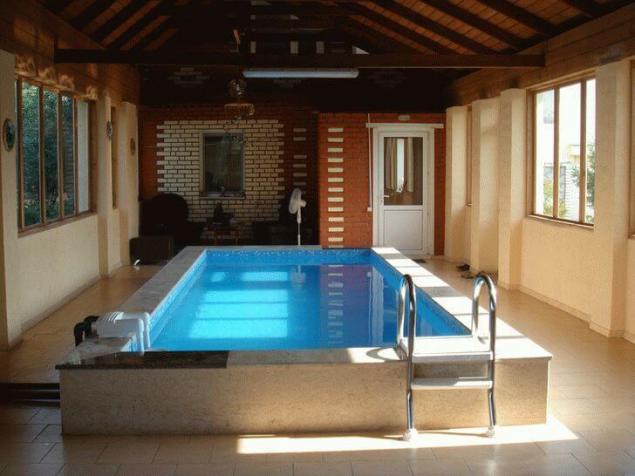
Classic font is a relatively small capacity (sometimes mobile, made of wood) filled with cold water, intended to contrast water procedures. Traditionally, a font — attribute baths and a small swimming pool with sauna. While in the font, unlike pool, is a more frequent change of water.
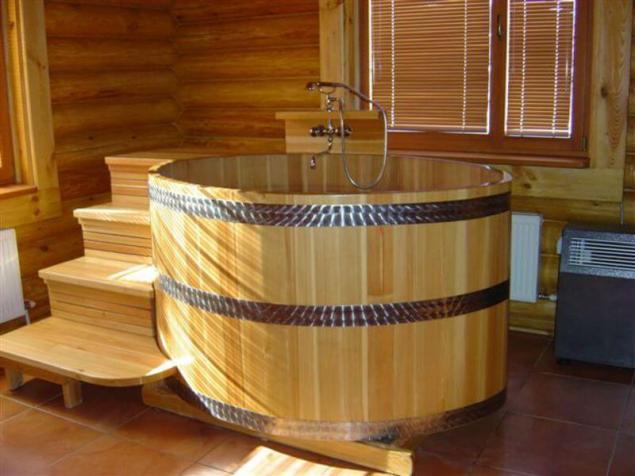
The pool is primarily designed for entertainment, swimming pool with attractions — waterfalls, geysers, massage jets, counter-current (counter-flow) often becomes the center of attraction for the whole family.
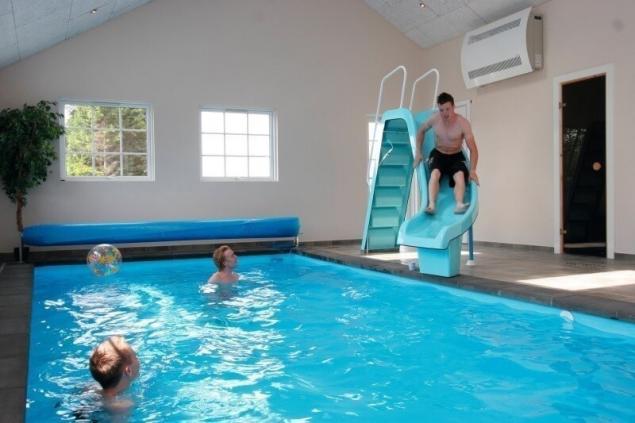
Of course, make the house full pool "in three lanes and 25 meters" can afford a few. So often developers choose therapeutic, small pools (sometimes also called font), equipped SPA with a volume of water in the bowl of 1-3 m3.
The second option — health and Wellness pools, a volume of from 3 to 8 m3, as well as the first home of "reservoir" are used as addition to the sauna, the Hammam, or bath complex.
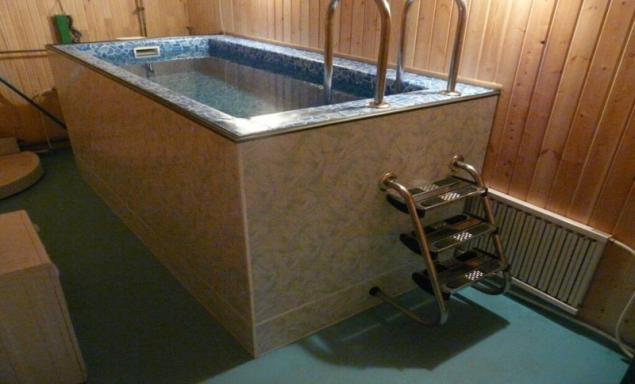
To swim, build more large-scale construction — pool 15-50 m3, with a depth of 1.5 meters (which is enough for swimming). Accordingly, the requirements for such structures, as well as their price increase is directly proportional to their size.
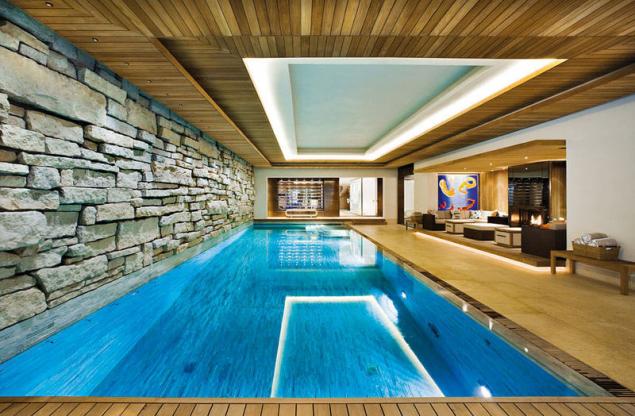
But even if you want to build the house in a relatively small pool, bowl size 3x5 meters in advance to prepare for large expenses. So before you begin construction, you should ask yourself the question: "do we really need a pool house?". To answer it, and to make an informed decision, we need to understand what is required to be placed under the "wet" area.
The construction of the pool and the baptismal font in the house: pros and cons
The advantages of placing the pool in the house is obvious — use it when you want. This is the main driving force of the desire to build it.
If the advantages of placing the pool in the house is obvious, cons often become a real "underwater reefs", which can break the desire to build it.
The nuances of the construction of a pool or baptismal font in the house
Already from the name "wet" area it is clear that the area must meet a number of specific characteristics. It is a reliable sealing, use water-resistant materials and formulations for the finishing of "wet" zone, and the bringing of all necessary communications, a well designed ventilation system.
In addition, pool or plunge pool in the house is always additional weight. Stone bowl, the construction of which took tens of cubic meters of concrete, plus the water in it, have a significant load on the underlying structure or layers of the soil.
There are projects of houses, where the pool in the basement, on the ground floor, or located on the second floor (in this case on the floor and walls bear the additional load).
Based on this, remember this rule — the swimming pool is designed together with the house. The main mistake — to erect a building, and then think how to put a swimming pool, or try to "cram" a large plunge pool in the basement. A base plate in this case can not withstand the load and crack.
The pool and the house needs to be two independent from each other structures. The bowl of the pool cannot be associated with the walls of the house, floors of a building or wall must not be supported by the bowl.Special attention should be paid to the strength and integrity of the bowl, and takieddine waterproofing "wet" areas. Reinforcement, grade of concrete, additives, giving the mixture increased water resistance, waterproofing, and additional equipment, which will be equipped with swimming pool, availability of all necessary engineering communications — all this is taken into account in advance, not after.
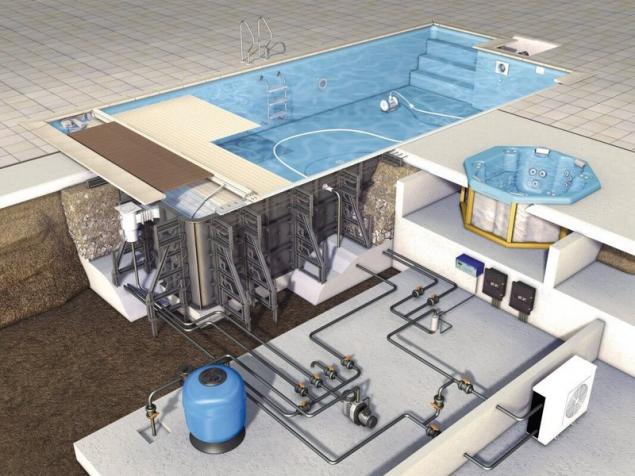
Waterproofing of the bowl should be continuous across the surface. In casting the bowl made of concrete (if you select this option of construction) it is undesirable to do cold joints in the future they can become a possible place of the leak. Hence the walls of the bowl are poured at one time.
In addition, if the planned construction of a pool house, you need to find out, whether will sustain the soil the total mass of the building and the bowl filled with water, or the soil may eventually give uneven settlement, which will lead to an emergency situation. For example, the walls of the cottage or the Cup will crack, and water will flow out, pidmyvayuchy Foundation. In this case, will need expensive repairs.
The desire to build a pool or a plunge pool in the house automatically leads to the necessity of solving a number of engineering tasks. Moreover, the construction of the bowl is not always one of the most difficult tasks. The "wet" area in the house – the problem of settling
The organization of space for a pool or plunge pool and availability of floor space – one of the main factors influencing the final decision of their construction. Ie — area of residential and non-residential premises added additional space that will host a pool or a plunge pool.
Given that the pool swim every day, come to the fact that the cottage will appear in the room, which will actually stand a large amount of time. The cottage will have to build larger, and all its engineering systems design and tie for the maintenance of the pool.
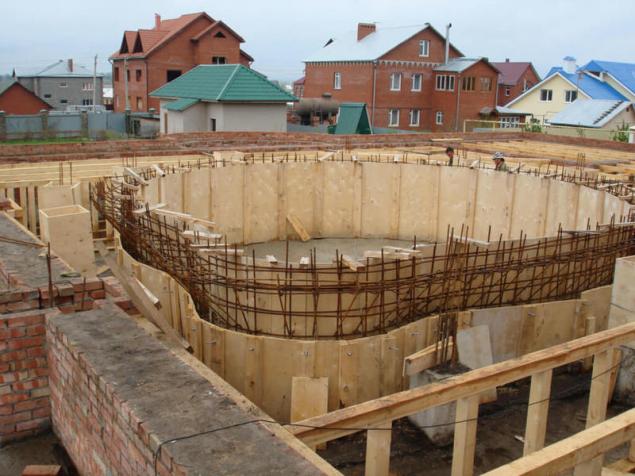
Typically, a full-fledged indoor pools are built in houses with an area of 300-400 sq m and more.But even having decided on the construction of a huge house (which still have to maintain and heat), it is necessary to ask the opinion of the household — how often they will use the pool, and do not turn it into an expensive and useless toy that requires constant investment.
In addition, many developers neglect such an important moment of development of "wet" areas like ventilation. In one of his past articles we have already talked about the features of ventilation in "wet" areas, but again — a large amount of water residing in the house is a source of high humidity.
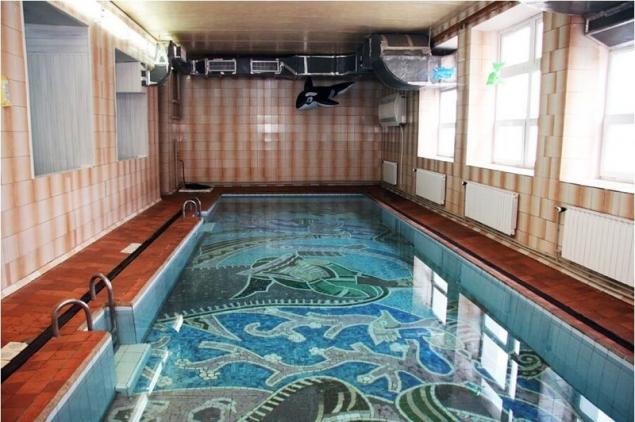
1 sq. m of pool per day evaporates approximately 0.25 (the number given for reference) liters of fluid. Without installation of ventilation (calculated with reference to the area of the water in the pool or the baptismal font and water temperature and air in the room), the pool house will turn into a permanent headache.
In the absence of ventilation of evaporated water will condense onto and falls in drops on surfaces "wet" areas. Over time, this will lead to the deterioration of furnishings, moisture, occurrence of fungi and unpleasant odors.
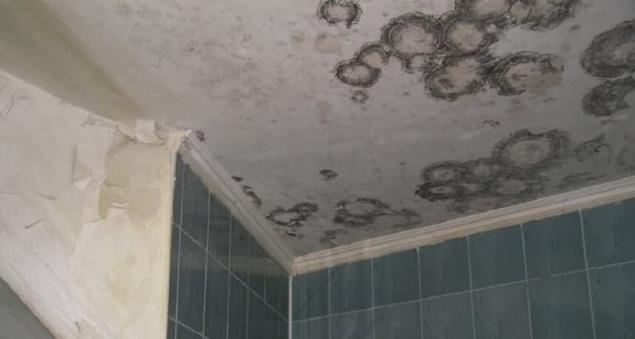
And this is just one of the many factors that complicate the arrangement of the pool in the "wet" area of the house. Add the need for HVAC and filtration equipment, the water-heating arrangement in the room mortgages under further communication.
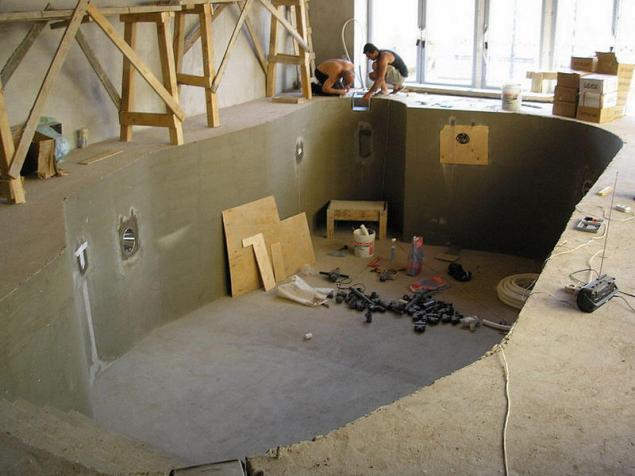
It is also necessary to think in advance where to drain water from the pool or the baptismal font. Septic tank or storm sewer can not handle the dumping of a large volume. I.e., all systems in the house and the room under the pool must be calculated with a margin for its long-term operation. Don't forget to add installation costs in the "wet" premises of the additional routes under the cables, the installation of another switch Board the cost of buying waterproof switches and circuit breakers, pumps and energy costs. As for the operation of the pool must be equipped with appropriate equipment powered by electricity. Calculate whether there is enough allocated capacity for normal operation of the "wet" areas in the house. For reference, I use the following approximate numbers given by the user with the nickname Besrom:
The cost of construction and maintenance of "wet" areas in a country house
The "wet" area in the house can become a significant cost factor because of the pool or the plunge pool must be filled with water to maintain it at a constant level (water evaporates; to reduce the level of evaporation, and pool shelter with a special blanket or blinds). Have to spend on chemicals for disinfection of water and most importantly — acceptable to maintain positive temperature in winter. Ie water pool will have to heat up. To cope with this heating system at home? Given that the climate in our country is severe, and the heating season, depending on the region you live in can last 6-8 months, the pleasure from the water treatments may be costly.
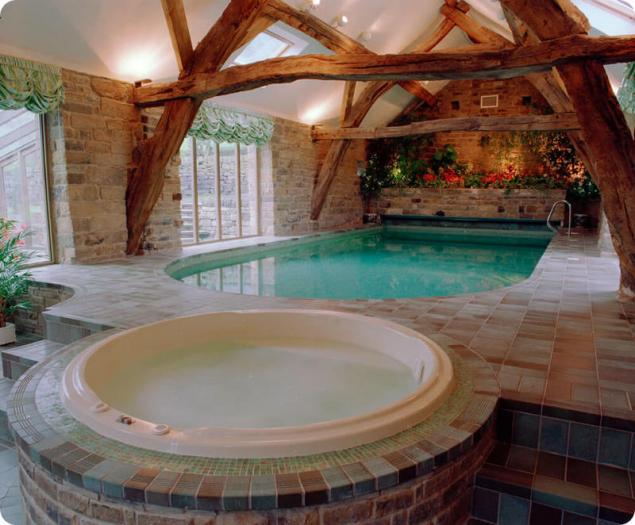
Summing up
Undoubtedly, to have a pool house prestigious and useful, but only provided enough funds for its construction and, importantly, ongoing operation and maintenance. In other cases, it is necessary to think ten times before deciding on its construction. Therefore, the arrangement of the "wet" areas or placement for adoption of water treatments, in the first place, must be guided by common sense and, as an option, instead of a full large swimming pool — to build a small pool or plunge pool. Moreover, on our portal there is extensive experience in building similar structures.
P. S. And remember, only by changing their consumption — together we change the world! ©
Source: www.forumhouse.ru/articles/house/6827

Many novice developers think that to make a pool or a plunge pool not very difficult. Enough desire, available funds, and the dream came true. You overlooked the many pitfalls and peculiarities lurking in the "wet" area in the house. This is what we will cover in today's material from which you will learn:
- Than pool different from the usual font.
- Whether to build a "wet" area in the house.
- What kind of nuances you should know before construction of the pool house.
- How much will cost the construction of the pool house.
But before proceeding to the peculiarities of arrangement of the font or pool in a private home, we need to understand these concepts, because already at this initial stage there is confusion, because often the font is called pool, and Vice versa.
A pool is a complex engineering and hydraulic structure, which includes a bowl, filtration equipment for water treatment, pumping equipment required for recirculation (shift and, if necessary, draining water), the water heating system.

Classic font is a relatively small capacity (sometimes mobile, made of wood) filled with cold water, intended to contrast water procedures. Traditionally, a font — attribute baths and a small swimming pool with sauna. While in the font, unlike pool, is a more frequent change of water.

The pool is primarily designed for entertainment, swimming pool with attractions — waterfalls, geysers, massage jets, counter-current (counter-flow) often becomes the center of attraction for the whole family.

Of course, make the house full pool "in three lanes and 25 meters" can afford a few. So often developers choose therapeutic, small pools (sometimes also called font), equipped SPA with a volume of water in the bowl of 1-3 m3.
The second option — health and Wellness pools, a volume of from 3 to 8 m3, as well as the first home of "reservoir" are used as addition to the sauna, the Hammam, or bath complex.

To swim, build more large-scale construction — pool 15-50 m3, with a depth of 1.5 meters (which is enough for swimming). Accordingly, the requirements for such structures, as well as their price increase is directly proportional to their size.

But even if you want to build the house in a relatively small pool, bowl size 3x5 meters in advance to prepare for large expenses. So before you begin construction, you should ask yourself the question: "do we really need a pool house?". To answer it, and to make an informed decision, we need to understand what is required to be placed under the "wet" area.
The construction of the pool and the baptismal font in the house: pros and cons
The advantages of placing the pool in the house is obvious — use it when you want. This is the main driving force of the desire to build it.
If the advantages of placing the pool in the house is obvious, cons often become a real "underwater reefs", which can break the desire to build it.
The nuances of the construction of a pool or baptismal font in the house
Already from the name "wet" area it is clear that the area must meet a number of specific characteristics. It is a reliable sealing, use water-resistant materials and formulations for the finishing of "wet" zone, and the bringing of all necessary communications, a well designed ventilation system.
In addition, pool or plunge pool in the house is always additional weight. Stone bowl, the construction of which took tens of cubic meters of concrete, plus the water in it, have a significant load on the underlying structure or layers of the soil.
There are projects of houses, where the pool in the basement, on the ground floor, or located on the second floor (in this case on the floor and walls bear the additional load).
Based on this, remember this rule — the swimming pool is designed together with the house. The main mistake — to erect a building, and then think how to put a swimming pool, or try to "cram" a large plunge pool in the basement. A base plate in this case can not withstand the load and crack.
The pool and the house needs to be two independent from each other structures. The bowl of the pool cannot be associated with the walls of the house, floors of a building or wall must not be supported by the bowl.Special attention should be paid to the strength and integrity of the bowl, and takieddine waterproofing "wet" areas. Reinforcement, grade of concrete, additives, giving the mixture increased water resistance, waterproofing, and additional equipment, which will be equipped with swimming pool, availability of all necessary engineering communications — all this is taken into account in advance, not after.

Waterproofing of the bowl should be continuous across the surface. In casting the bowl made of concrete (if you select this option of construction) it is undesirable to do cold joints in the future they can become a possible place of the leak. Hence the walls of the bowl are poured at one time.
In addition, if the planned construction of a pool house, you need to find out, whether will sustain the soil the total mass of the building and the bowl filled with water, or the soil may eventually give uneven settlement, which will lead to an emergency situation. For example, the walls of the cottage or the Cup will crack, and water will flow out, pidmyvayuchy Foundation. In this case, will need expensive repairs.
The desire to build a pool or a plunge pool in the house automatically leads to the necessity of solving a number of engineering tasks. Moreover, the construction of the bowl is not always one of the most difficult tasks. The "wet" area in the house – the problem of settling
The organization of space for a pool or plunge pool and availability of floor space – one of the main factors influencing the final decision of their construction. Ie — area of residential and non-residential premises added additional space that will host a pool or a plunge pool.
Given that the pool swim every day, come to the fact that the cottage will appear in the room, which will actually stand a large amount of time. The cottage will have to build larger, and all its engineering systems design and tie for the maintenance of the pool.

Typically, a full-fledged indoor pools are built in houses with an area of 300-400 sq m and more.But even having decided on the construction of a huge house (which still have to maintain and heat), it is necessary to ask the opinion of the household — how often they will use the pool, and do not turn it into an expensive and useless toy that requires constant investment.
In addition, many developers neglect such an important moment of development of "wet" areas like ventilation. In one of his past articles we have already talked about the features of ventilation in "wet" areas, but again — a large amount of water residing in the house is a source of high humidity.

1 sq. m of pool per day evaporates approximately 0.25 (the number given for reference) liters of fluid. Without installation of ventilation (calculated with reference to the area of the water in the pool or the baptismal font and water temperature and air in the room), the pool house will turn into a permanent headache.
In the absence of ventilation of evaporated water will condense onto and falls in drops on surfaces "wet" areas. Over time, this will lead to the deterioration of furnishings, moisture, occurrence of fungi and unpleasant odors.

And this is just one of the many factors that complicate the arrangement of the pool in the "wet" area of the house. Add the need for HVAC and filtration equipment, the water-heating arrangement in the room mortgages under further communication.

It is also necessary to think in advance where to drain water from the pool or the baptismal font. Septic tank or storm sewer can not handle the dumping of a large volume. I.e., all systems in the house and the room under the pool must be calculated with a margin for its long-term operation. Don't forget to add installation costs in the "wet" premises of the additional routes under the cables, the installation of another switch Board the cost of buying waterproof switches and circuit breakers, pumps and energy costs. As for the operation of the pool must be equipped with appropriate equipment powered by electricity. Calculate whether there is enough allocated capacity for normal operation of the "wet" areas in the house. For reference, I use the following approximate numbers given by the user with the nickname Besrom:
- Filter system 0.55 kW.
- Illumination of the two led lamps 12 volts 100 watts.
- Control system, the valve — 0.50 kW.
- Backflow — 3.5 kW.
- Waterfall — 2 kW.
The cost of construction and maintenance of "wet" areas in a country house
The "wet" area in the house can become a significant cost factor because of the pool or the plunge pool must be filled with water to maintain it at a constant level (water evaporates; to reduce the level of evaporation, and pool shelter with a special blanket or blinds). Have to spend on chemicals for disinfection of water and most importantly — acceptable to maintain positive temperature in winter. Ie water pool will have to heat up. To cope with this heating system at home? Given that the climate in our country is severe, and the heating season, depending on the region you live in can last 6-8 months, the pleasure from the water treatments may be costly.

Summing up
Undoubtedly, to have a pool house prestigious and useful, but only provided enough funds for its construction and, importantly, ongoing operation and maintenance. In other cases, it is necessary to think ten times before deciding on its construction. Therefore, the arrangement of the "wet" areas or placement for adoption of water treatments, in the first place, must be guided by common sense and, as an option, instead of a full large swimming pool — to build a small pool or plunge pool. Moreover, on our portal there is extensive experience in building similar structures.
P. S. And remember, only by changing their consumption — together we change the world! ©
Source: www.forumhouse.ru/articles/house/6827
